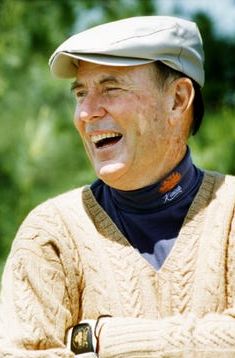January 11, 2020
Remembering Pete Dye
 I have always wished that I could design a golf course. I've seen new courses and said to myself, "I could've done better". Pete Dye was a very successful insurance salesman in Indianapolis and chairman of the Greens Committee at his home course at the Country Club of Indianapolis. He oversaw the renovation of several holes at CCI and thought "I can do that". Well he did more than just do that, he along with his wife Alice, made a lasting impression on golf architectural that will be his legacy. He passed away a few days ago at age 94 after a long struggle with dementia.
I have always wished that I could design a golf course. I've seen new courses and said to myself, "I could've done better". Pete Dye was a very successful insurance salesman in Indianapolis and chairman of the Greens Committee at his home course at the Country Club of Indianapolis. He oversaw the renovation of several holes at CCI and thought "I can do that". Well he did more than just do that, he along with his wife Alice, made a lasting impression on golf architectural that will be his legacy. He passed away a few days ago at age 94 after a long struggle with dementia.
In 1978, I became the head professional at Broadmoor Country Club, a Donald Ross design, in Indianapolis. I lived a half hour away in Carmel and close to Crooked Stick Golf Club. This was Pete Dye's creation and baby. He lived in Indianapolis and he consistently made improvements on his personal masterpiece. I saw him there occasionally, but never formally met. I was fortunate to play there numerous times and witness his greatness. He is remembered for his railroad ties, small pot bunkers, and the iconic 17th island green at TPC in Florida. But it was his artistry to paint a visual picture for each golf shot that made him stand out from the rest of his contemporaries. In my mind, only Tom Fazio is in his league of modern designers.
While in the military he was stationed at Ft. Bragg in North Carolina and served out his hitch, just after the war, working on the grounds crew for the base's golf course. Pinehurst #2 was close to the base and Pete played it continuously for six months. He got to know Donald Ross the designer of Pinehurst #2 and also the architect of the course at Ft. Bragg. This experience and knowledge must have had a lasting effect on this confidence that he could succeed in building golf courses.
Pete was also a fine player, winning the Indiana Amateur and qualifying for the 1957 US Open. As a player you look how to attack each hole. Pete wanted you to think on each shot. His genius was that what looked like the easy way was usually the hardest way. One side looked like disaster, but the closer you stayed on that side the better. I have played many of his greatest works and I never thought they were unfair or gimmicky. He made you hit the right shot, if you couldn't, there was a safe shot, but you weren't going to make par. A great golf course challenges you and rewards you for a well-played shot. A mistake can be a double bogie, but the good shot should give you a chance for a birdie. Pete Dye's courses were unforgiving, but fair. I've come to appreciate that in great courses.
Although I have met Pete Dye, I didn't know him personally, but I did know many people who did. Two of those people were Ernie Vossler and Joe Walser, both PGA professionals, and directors of Landmark Golf Corporation. In the 1970's and 80's, Landmark was the leading golf course development company in the country and the Oak Tree logo was seemingly everywhere. Over 10 prominent PGA Tour professionals represented the Oak Tree brand. Ernie and Joe wanted only the best and they chose Pete Dye to be their main architect. Over a span of thirty years, Pete built 17 championship golf courses for Landmark. His best Landmark courses were PGA West Stadium course, Oak Tree National, and the Mountain and Dunes courses at La Quinta Resort. Ernie told me that Pete tirelessly walked the entire property before starting his design. Ernie took me on a tour of PGA West while under construction and we watched Pete on a small skip-loader personally sculpting the 10th green. When you got a Pete Dye golf course, you got the personal touch.
The TPC Stadium course at Sawgrass, the home of the Players Championship, will probably be Dye's most famous work. Oak Tree National, Crooked Stick, and Harbour Town are also well known and in that class, but the hardest, in my experience, is the PGA West Stadium course. When originally designed, the PGA Tour, for the Bob Hope Desert Classic, wouldn't play it because of it's difficultly. Ernie's instruction to Pete was to make the toughest golf course possible and he gave him 300 acres of flat desert as his canvas. Pete moved more sand than any project and created a masterpiece. Unfortunately, it has since been shortened and some of the approach shots eased, but it remains a classic tournament course. I got to play it when it first opened from the dead back tees and it continues to be the most challenging, fair golf course that I have played.
I got to design four bunkers at Lakewood Country Club in Colorado. I planted three strategic trees on Donald Ross's Broadmoor Country Club in Indianapolis. But that has been the extent of my contribution to golf course design. Pete Dye saw that he could do something better. He took advanced courses in agronomy at Purdue University and embarked on a new profession. Along with his wife of sixty-eight years, Alice, they revolutionized modern golf architecture. He lived his passion and left physical evidence of his legacy that will be with us a long time.



